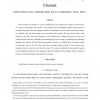Free Online Productivity Tools
i2Speak
i2Symbol
i2OCR
iTex2Img
iWeb2Print
iWeb2Shot
i2Type
iPdf2Split
iPdf2Merge
i2Bopomofo
i2Arabic
i2Style
i2Image
i2PDF
iLatex2Rtf
Sci2ools
CORR
2010
Springer
2010
Springer
Secure Communication over Parallel Relay Channel
We investigate the problem of secure communication over parallel relay channel in the presence of a passive eavesdropper. We consider a four terminal relay-eavesdropper channel which consists of multiple independent relay-eavesdropper channels as subchannels. For the discrete memoryless model, we establish outer and inner bounds on the rate-equivocation region. The inner bound allows mode selection at the relay. For each subchannel, secure transmission is obtained through one of the two coding schemes at the relay: decoding-and-forwarding the source message or confusing the eavesdropper through noise injection. For the Gaussian memoryless channel, we establish lower and upper bounds on the perfect secrecy rate. We show that lower and upper bound coincide in some special cases, including when the relay does not hear the source. The results established for the parallel Gaussian relay-eavesdropper channel are then applied to study the fading relay-eavesdropper channel. Analytical results...
Related Content
| Added | 16 May 2011 |
| Updated | 16 May 2011 |
| Type | Journal |
| Year | 2010 |
| Where | CORR |
| Authors | Zohaib Hassan Awan, Abdellatif Zaidi, Luc Vandendorpe |
Comments (0)

